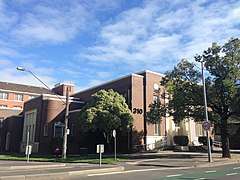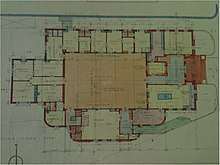Repatriation Commission Outpatient Clinic
| Repatriation Commission Outpatient Clinic | |
|---|---|
 Repatriation Commission Outpatient Clinic | |
| General information | |
| Architectural style | Art Deco |
| Town or city | 310 St Kilda Road, Melbourne |
| Country | Australia |
| Coordinates | 37°49′43″S 144°58′15″E / 37.828492°S 144.970900°ECoordinates: 37°49′43″S 144°58′15″E / 37.828492°S 144.970900°E |
| Construction started | 1936 |
| Completed | 1937[1] |
| Cost | £24,000 |
| Client | Repatriation Commission |
| Owner | Department of Defence, Australia |
| Design and construction | |
| Architect | George Hallendal |
The Repatriation Commission Outpatient Clinic at 310 St Kilda Road, Melbourne, Australia, is of architectural and historical significance as it is the only remaining example of a Repatriation Commission Outpatient Clinic in Australia. Significantly the building was constructed for World War 1 veterans nearly 20 years after the end of the war.
Post-World War I

In 1936 the Repatriation Commission took control of a parcel of land on the corner of St Kilda Rd and Coventry St from the Department of Defence to construct a facility to address the needs of the large population of World War 1 veterans. On this site the Repatriation Commission Outpatient Clinic was built adjacent to Victoria Barracks, Melbourne, it was opened on 15 November, 1937[2] , to provide a greater level of care to veterans. The building was designed by George Hallendal, under the supervision of Commonwealth Works Department Director, H. L. McKennall. Within months of opening as many as 400 prescriptions were being administered daily.[3]
The design of the Repatriation Clinic created some controversy with Sir Arthur Streeton criticising [4] the use of brown brick in contrast to the established bluestone brick of Victoria Barracks.
Post-World War II
Up to 250 veterans visited the clinic each day. An extension was added to the building in the late 1940's for a war neurosis clinic, designed by D. B. Windebank.[5]
The Repatriation Clinic ceased operations in 1980 and was handed back to the Department of Defence. From this point it was used as the Maintenance Engineering Agency (MEA), now the Land Engineering Agency (LEA), until December 1995. The former Repatriation Clinic has been reportedly vacant since 1999[5] while the MEA newsletter (Maintenance News) No's. 66 (Sep 1995) and 67 (Dec 1995) indicates the last organisation to occupy the Repatriation Clinic moved out in 1995.
In 2016 the Australian Labor Party (ALP) released a policy[6] to turn the clinic into an Australian National Veterans Arts Centre (ANVAC) following lobbying by the ex-service organisation and veterans charity, the Australian National Veterans Arts Museum (ANVAM).
In the same year the Department of Defence indicated the former Repatriation Clinic would be sold that attracted some political[7] and media attention.[8] Later the Department of Defence indicated negotiations were underway to transfer the property to the State Government of Victoria. A nomination was submitted to Heritage Victoria for the listing of the Repatriation Clinic on the State Heritage Register. A report (Ref: 200349) was prepared for the Victorian Heritage Council in May 2017 but not considered by the Council pending the outcome of the sale process.
Veterans War Service
Veterans who attended the Repatriation Clinic between 1937 and 1975 for medical and allied health support saw service in the following wars:
- World War 1
- World War 2
- Korean War
- Malayan Emergency
- Vietnam War
References
- ↑ "NEW DIGGERS' CLINIC". The Weekly Times (2, 390). Victoria, Australia. 18 September 1937. p. 7. Retrieved 1 October 2018 – via Trove. , Costing £16.010, the new clinic for out-patients of the Repatriation Commission in St. Kilda Road, Melbourne, adjacent to Victoria Barracks, will be opened in a month
- ↑ "SOLDIER PATIENTS £24,000 CLINIC". The Herald. Victoria, Australia. 11 November 1937. p. 12. Retrieved 1 October 2018 – via Trove. , THE new building will re-place the present obsolete clinic in the basement of the Department's central ad-ministrative building. These quarters, designed only as a makeshift, are over-crowded, ill-lit and old-fashioned, and have long ceased to meet the require-ments of the medical staff and the daily average of 200 patients who are treated at the clinic.
- ↑ "SOLDIERS' OUTPATIENTS CLINIC". The Evening News. Queensland, Australia. 22 January 1938. p. 2. Retrieved 1 October 2018 – via Trove. , The Minister for Repatriation (Senator Foll) said today that the out-patient clinic for ex-soldier, provided in Melbourne by the Repatriation Commission, was giving splendid service.
- ↑ "Brick Clinic in St. Kilda Road Condemned". The Argus. Victoria, Australia. 5 March 1937. p. 12. Retrieved 4 October 2018 – via Trove. , "A building in this part of St Kilda road in anything but bluestone will ruin this magnificent boulevard" said Sir Arthur Streeton yesterday.
- 1 2 "Former Repatriation Outpatient Building - Victoria Barracks". Victoria Heritage Database. Heritage Council of Victoria. Retrieved 6 October 2018.
- ↑ "The Australian National Veterans Arts Centre in Melbourne". Vic, Australia. 17 May 2016. p. online. Retrieved 4 October 2018 – via APH. , The building will be remediated and restored by the Department of Defence, before being returned to its original purpose as a centre caring for veterans.
- ↑ "Government miss opportunity to help our veterans". Vic, Australia. 14 February 2017. p. online. Retrieved 7 October 2018 – via APH. , An opportunity has gone missing for the Turnbull Government to help veterans as Defence confirm the sale of 310 St. Kilda road at Victoria Barracks.
- ↑ "Arts, not apartments, says veterans' group as defence building goes to sale". Sydney Morning Herald. NSW, Australia. 20 February 2017. p. online. Retrieved 4 October 2018 – via SMH. , ...its proposed sale has been greeted with fury by a small band of veterans who, for three years, have quietly lobbied the department to turn it into an art gallery for returned service men and women.